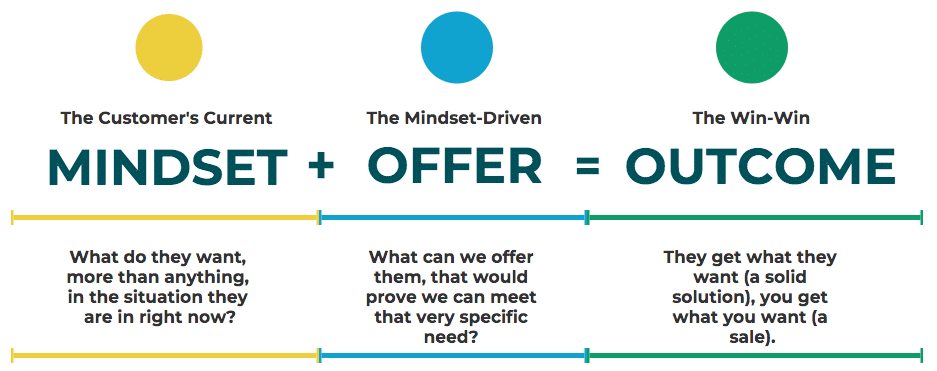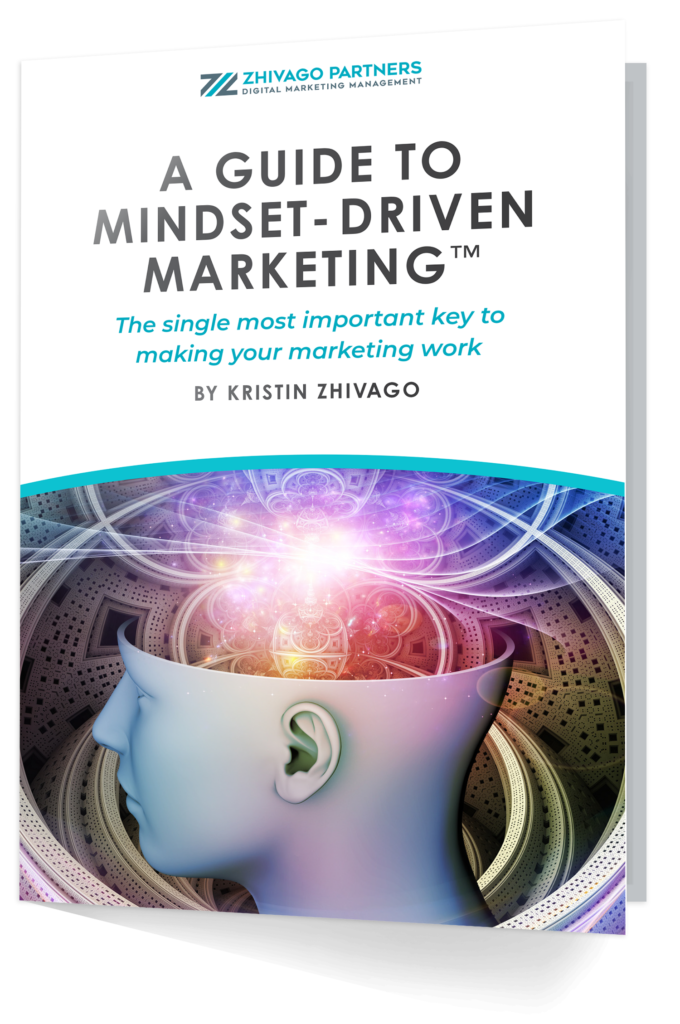Mindset-Driven Marketing
The key to successful marketing, no matter what you're selling.
Absolutely nothing in marketing matters more than the customer’s Mindset when they set out to buy. Kristin Zhivago explains Mindset-Driven Marketing.



Kristin Zhivago
President
“My marketing isn’t working.” That’s what all business owners and managers say to us when they come to us for help.
Why isn’t their marketing working? Because all of their marketing efforts are focused on who the customer is (personas) and where the customer is gathering (channels such as social, search engines, online communities and sites, etc.).
Their efforts were missing the most important element in the marketing mix: The customer’s Mindset when they set out to buy.
If you understand the customer’s Mindset, and make an offer that appeals to their specific Mindset, all of your marketing efforts, in any channel, will work as they should. Your customer will get what he or she wants, and you will get what you want: a sale.
What is a customer’s Mindset?
It starts with a need. A very specific need. They decide that they need or want something, and they are willing to spend money to get it. We know this, when we are thinking and acting like buyers ourselves. As buyers, we fast-forward through commercials and ignore ads online because they are not speaking to our Mindset.
We tend to forget this reality when we are trying to sell.
We get too distracted by demographics and psychographics and channels, going out to the market with vague, generalized messages that don’t appeal to our customer’s Mindset. “Save time!” “Save money!” “Look better!”
The customer’s Mindset consists of desires, concerns, and questions.
Manufacturers do an inadequate job of addressing these concerns and answering these questions, because they assume they know what the customer is thinking.
The years I have spent working on this problem has convinced me that these assumptions have caused more financial grief than any other aspect of business management. Interviewing thousands of customers for hundreds of companies proved to me that what company managers assumed about customers was incorrect.
This is why customers depend so much on each other for advice and information. Customers looking for the same item share the same concerns and questions. They have a similar Mindset. This is why the “customers answering other customers’ questions” section of Amazon is so powerful and popular.
If you want to sell successfully, you need to understand their Mindset. The best way to do this is to interview customers who have already bought from you, as I recommend (and provide specific instructions for) in my book, Roadmap to Revenue: How to Sell the Way Your Customers Want to Buy.
Customers who have already bought from you have a vested interest in your success, will be willing to talk, and are no longer in buying/negotiation mode. If you ask them properly, you will get the information you need.
Let’s look at the three buyer needs that must be met before they will buy from you.
Desires. Customer desires are much more specific than marketers assume. One person might want a washing machine that is super quiet. Another might want a machine that is kind to delicate clothing. The good news is, most products and services have only a few desires associated with them, which can then be addressed by building Mindset segments, characterizing customers by their specific desires. Campaigns can then be built, making offers that appeal to those specific Mindsets.Doing these things will put you miles ahead of any competitors who are still wasting money making vague, non-specific promises that will be irrelevant to most buyers.
Concerns. All buyers are skeptical. Anyone who has bought more than a few items in their lives has experienced buyer’s remorse. And yet sellers behave as if no one has ever been disappointed. That’s a Mindset gap right there—treating the customer as someone who has no experience related to your product or service. In our case, for example, business owners and managers come to us after they have spent a lot of money, effort, and time on campaigns that didn’t work. Are they skeptical? You bet, and with good reason. All buyers have concerns, and the universal dismissal by a quota-hungry salesperson (“No problem!”) is not an answer they can accept.
Questions. The questions customers ask will include those relating to their specific Mindsets (e.g., “How quiet is this?” “How gentle is it?”), but will also include more universal questions, such as, “How big is this?” “How will it get delivered and hooked up?” In my book, I go into great detail about the types of questions customers ask, as they purchase Light, Medium, Heavy, and Intense Scrutiny products and services. Your product or service falls into one of those four categories. Answering those questions to the buyer’s satisfaction will put you far ahead of your competitors.
Obviously you really need to understand their Mindset, before you craft an offer.



Crafting an Offer
Once you understand and have documented your customer’s Mindset (or Mindsets, if there are several “types”), it’s time to craft an offer. Note that we are still not concerned with channels (how and where you will make this offer). That comes last.
The “offer” is your product or service itself, if you are selling a Light or Medium Scrutiny product or service. For the more complex products, which involve a deeper level of scrutiny and often involve others in the buying decision, the buyer doesn’t buy right away. They have many more questions, do a lot more research, and take longer to make a decision. These buyers are best served with information that helps them in some way and makes them familiar with the value you can bring to them. They need to be able to trust you before they invest money (or their reputation within the company) in your product or service.
Whatever you are selling, it must be obvious from the moment they lay eyes on your copy or land on a page that you are totally in sync with their Mindset. That you understand their desires, concerns, and questions, and you are able to give them what they’re looking for.
No “one size fits all”
Another big mistake made in marketing is to assume that “a message or channel that worked for one product will work for another.” Your customers have very specific Mindsets, and they will go looking for you in a unique way. Your product or service—and your company—satisfies that Mindset in a unique way. What works for one company, even a company in the same industry, is not guaranteed to work for you.
It’s best to ignore channels and personas—and even the competition—until you have identified, understood, and documented the Mindsets that bring people to you and result in a sale. Then, build an offer that perfectly addresses that Mindset, and make that offer in the channels where your buyers are likely to go looking for you. If you have interviewed your current customers and understand where and how they would look for your product or service, the “which channel should we use?” question answers itself.
Doing these things will put you miles ahead of any competitors who are still wasting money making vague, non-specific promises.
Of course, we can help with all of this. It’s what we do.
Download Your Own Free Copy of Kristin Zhivago's
Guide To Mindset-Driven Marketing
Want all of your marketing to start working for you, and bringing in the best leads for your business?
Kristin spells out how, in this “put this information right to work” guide.




